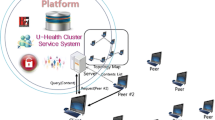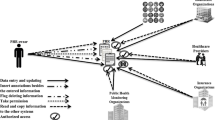Abstract
In an era of many diseases and increased longevity, more attention has been paid to chronic diseases that require constant health care. Under this circumstance, the development of research and development (R&D) for smart-device-based constant health care has drawn great attention. With the emergence of wearable devices, personal health devices (PHDs), and smartphones, various contents for constant health care have been developed. By using these devices, the users are able to collect personal health records (PHRs) that include data such as activity amount, heart rate, stress, and blood sugar. The range of the collected PHRs can be limited depending on the equipment or the surrounding environment. To overcome this problem, it is necessary to make a comparison with similar users in a cluster. Also, it is necessary to provide a service that can analyze and visually display the collected personal-health information. In this paper, we propose the mining of health-risk factors using the PHR similarity in a hybrid P2P network. This is a method of predicting a user’s health status using similarity-based data mining, where the PHRs are employed in a hybrid P2P environment consisting of a peer, a server, and a gateway. In a hybrid P2P environment, a user receives feedback on the result of a structured-data analysis. A peer searches for a different peer and gateway through a server and exchanges information. Depending on the data type, the PHR is divided into medical health examination, self-diagnosis, and personal-health data. The medical health examination contains the personal-health data that are generated regularly by a medical institution. Self-diagnosis represents the data of mental health, pains, and fatigue that can be changed often but cannot be collected by devices. Personal-health data mean the data that can be collected by individuals in everyday life. For the PHR-data analysis, an index is given to each attribute, and preprocessing is performed after a binary-code conversion. To predict a user’s health status, the PHR data are clustered on the basis of similarity in a hybrid P2P environment. The similarity between a user’s PHR and a PHR that is searched for in the network is measured. After the measurement, an index is given to the PHR that meets the minimum similarity and the PHR is incorporated into a Similarity PHR Group. The Similarity PHR Group flexibly changes depending on a user’s PHR status and the statuses of the users who have accessed the hybrid P2P network. A representative value of the Similarity PHR Group is extracted and is then compared with the user’s PHR to judge the user’s health status. The proposed method is suitable for a smart health service for chronic diseases requiring constant care, elderly health, and aftercare. This is a user-oriented health-care and promotion service wherein a user’s health status can be predicted through the mining of the health-risk factors of PHRs.




Similar content being viewed by others
References
Chung K, Na Y, Lee JH (2013) Interactive design recommendation using sensor based smart wear and weather WebBot. Wirel Pers Commun 73(2):243–256
Jun IJ, Chung KY (2009) Life weather index monitoring system using wearable based smart cap. J Korea Contents Assoc 9(12):477–484
Amendola S, Lodato R, Manzari S, Occhiuzzi C, Marrocco G (2014) RFID technology for IoT-based personal healthcare in smart spaces. IEEE Internet Things J 1(2):144–152
Catholic University of Korea, Seoul ST. Mary’s Hospital. http://www.cmcseoul.or.kr/
Jung H, Chung KY, Lee YH (2015) Decision supporting method for chronic disease patients based on mining frequent pattern. Multimed Tools Appl 74(20):8979–8991
Chung K, Park RC (2016) PHR Open Platform Based smart health service using distributed object group framework. Clust Comput 19(1):505–517
Chung K, Kim JC, Park RC (2016) Knowledge-based health service considering user convenience using hybrid Wi-fi P2P. Inf Technol Manag 17(1):67–80
Health Insurance Review and Assessment Service (HIRA). http://opendata.hira.or.kr/
Mediplus Solution, Second Wind. http://www.medisolution.co.kr/
Hood L, Friend SH (2011) Predictive, personalized, preventive, participatory (P4) cancer medicine. Nat Rev Clin Oncol 8(3):184–187
Ashley EA (2015) The precision medicine initiative: a new national effort. J Am Med Assoc 313(21):2119–2120
Kim SH, Chung K (2016) Emergency situation monitoring service using context motion tracking of chronic disease patients. Clust Comput 18(2):747–759
Jung H, Yoo H, Chung K (2016) Associative context Mining for Ontology-Driven Hidden Knowledge Discovery. Clust Comput 19(4):2261–2271
Yoo H, Chung K (2017) PHR based diabetes index service model using life behavior analysis. Wirel Pers Commun 93(1):161–174
Jung H, Chung K (2015) Sequential pattern profiling based bio-detection for smart health service. Clust Comput 18(1):209–219
Kim JC, Jung H, Yoo H, Kim JH, Chung K (2017) Medical mining based silver smart platform for elderly health. In proc. of the 4th international conference for small & medium business 2017, pp 356–357
National Health Service Digital (NHS Digital). http://digital.nhs.uk/
Wang K, Li P, Chen L, Kato K, Kobayashi M, Yamauchi K (2010) Impact of the Japanese diagnosis procedure combination-based payment system in Japan. J Med Syst 34(1):95–100
Jung H, Chung K (2016) Knowledge-based dietary nutrition recommendation for obese management. Inf Technol Manag 17(1):29–42
Jung H, Chung K (2016) PHR based life health index mobile service using decision support model. Wirel Pers Commun 86(1):315–332
Chung K, Park RC (2016) P2P cloud network services for IoT based disaster situations information. Peer Peer Netw Appl 9(3):566–577
Jung H, Chung K (2016) P2P context awareness based sensibility design recommendation using color and bio-signal analysis. Peer Peer Netw Appl 9(3):546–557
Kim JC, Chung K (2017) Emerging risk forecast system using associative index mining analysis. Clust Comput 20(1):547–558
Kim JC, Chung K (2017) Depression index service using knowledge based crowdsourcing in smart health. Wirel Pers Commun 93(1):255–268
Chung KY (2011) Vital signal monitoring simulation system by various visual stimulus. J Korea Contents Assoc 11(1):1–8
Korea Informative Classification of Diseases. http://www.koicd.kr/
Jung H, Chung K (2006) Life style improvement mobile service for high risk chronic disease based on PHR platform. Clust. Comput. 19(2):967–977
Jung H, Chung K (2015) Ontology-driven slope modeling for disaster management service. Clust Comput 18(2):677–692
Chung K, Park RC (2017) Cloud based U-healthcare network with QoS guarantee for mobile health service. Clust Comput. https://doi.org/10.1007/s10586-017-1120-0
Song CW, Jung K, Chung K (2017) Development of a medical big-data mining process using topic modeling. Clust Comput https://doi.org/10.1007/s10586-017-0942-0
Acknowledgements
This work was supported by the GRRC program of Gyeonggi province. [2017-B03, Intelligence Information-based Security and Network Technology Research].
Author information
Authors and Affiliations
Corresponding author
Additional information
This article is part of the Topical Collection: Special Issue on Convergence P2P Cloud Computing
Guest Editor: Jung-Soo Han
Rights and permissions
About this article
Cite this article
Kim, JC., Chung, K. Mining health-risk factors using PHR similarity in a hybrid P2P network. Peer-to-Peer Netw. Appl. 11, 1278–1287 (2018). https://doi.org/10.1007/s12083-018-0631-7
Received:
Accepted:
Published:
Issue Date:
DOI: https://doi.org/10.1007/s12083-018-0631-7




